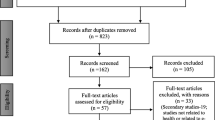Abstract
Although current oral health care initiatives have proved to be quite successful, a great number of individuals are unaware of how their choice of daily activities compromises their oral health. That is why newer technologies like WhatsApp can definitely serve as a platform to communicate dental advice, thereby strengthening the bridge between health and technology. The objective of the study was to assess the effectiveness of WhatsApp as a tool for providing health education on tobacco and oral cancer as compared to the conventional health education via PowerPoint. The study was a cluster randomized controlled trial, single-center study. The students of 18–24 years of age with WhatsApp application active in their mobile phones were included. Four classes with 182 students were randomly divided into intervention and control groups. Control group received health education on oral cancer using a PowerPoint presentation weekly, for a total of 4 weeks. Intervention group received health education through WhatsApp messaging thrice a week for 4 weeks. Pre- and post-health education knowledge scores were assessed using a questionnaire and compared using unpaired and paired two-sample t tests. Statistically significant increase in knowledge scores was seen in both groups, with highly significant improvement in the intervention group (p value = 0.00). Intergroup comparison showed no significant difference in knowledge scores at baseline, but a significant difference in post intervention knowledge scores (t = -15.05 p<0.001) WhatsApp can be a more effective tool for providing dental education on tobacco and oral cancer as compared to conventional audio-visual aids.

Similar content being viewed by others
References
World Health Organization. Tobacco. http://www.who.int/mediacentre/factsheets/fs339/en/. Accessed on 1/2/17 at 11.00 am.
Rao SVK, Mejia G, Roberts-Thomson K, Logan R (2013) Epidemiology of oral cancer in Asia in the past decade—an update (2000-2012). Asia Pac J Cancer Prev 10(14):5567–5577
Agrawal M, Pandey S, Jain S, Maitin S (2012) Oral cancer awareness of the general public in Gorakhpur city. India Asian Pac J Cancer Prev 13(10):5195–5199
Goyal G (2016) Knowledge, attitude and practice of chewing Gutka, areca nut, snuff and tobacco smoking among the young population in the northern India population. Asian Pac J Cancer Prev 17(11):4813–4818
Bhargava S (2016) Need of oral pre cancer awareness initiatives in India. Open Dent J 10:417–419
Schluter P, Lee M, Hamilton G, Coe G, Messer-Perkins H, Smith B (2015) Keep on brushing: a longitudinal study of motivational text messaging in young adults aged 18–24 years receiving Work and Income Support. J Public Health Dent 75(2):118–25
Hashemian TS, Kritz-Silverstein D, Baker R (2015) Text2Floss: the feasibility and acceptability of a text messaging intervention to improve oral health behavior and knowledge. J Public Health Dent 75(1):34–41
Sharma R, Hebbal M, Ankola AV, Murugabupathy V (2011) Mobile-phone text messaging (SMS) for providing oral health education to mothers of preschool children in Belgaum City. J Telemed Telecare 17(8):432–436
Hefler M, Freeman B, Chapman S (2013) Tobacco control advocacy in the age of social media: using Facebook. Twitter and change Tob Control 22(3):210–214
Duke JC, Hansen H, Kim AE, Curry L, Allen J (2014) The use of social media by state tobacco control programs to promote smoking cessation: a cross-sectional study. J Med Internet Res 16(7):e169
Underwood B, Birdsall J, Kay E (2015) The use of mobile app to motivate evidence based oral hygiene behavior. Br Dent J 219:E2
Zotti F, Dalessandri D, Salgarello S, Piancino M, Bonetti S, Visconti L, Paganelli C (2015) Usefulness of an app in improving oral hygiene compliance in adolescent orthodontic patients. The Angle Orthodontist 86(1):101–107
Li X, Xu ZR, Tang N, Ye C, Zhu XL, Zhou T, Zhaol Z (2016) Effect of intervention using a messaging app on compliance and duration of treatment in orthodontic patients. Clin Oral Invest 20:1849
Raiman L, Antbring R, Mahmood A (2017) WhatsApp messenger as a tool to supplement medical education for medical students on clinical attachment. BMC Med Educ 17(1):7
Carrard VC, Martins MA, Molina-Bastos CG, Gonçalves MR (2017) WhatsApp: a telemedicine platform for facilitating remote oral medicine consultation and improving clinical examinations-some considerations. Oral Surg Oral Med Oral Pathol Oral Radiol 123(3):408
Ganasegeran K, Renganathan P, Rashid A, Al-Dubai SA (2017) The m-Health revolution: exploring perceived benefits of WhatsApp use in clinical practice. Int J Med Inform 97:145–151
Askarian M, Kouchak F, Youssef M, Romito LM (2013) Comparing tobacco use knowledge, attitudes and practices between engineering students at a public and Islamic Azad University in Shiraz, Iran 2011. Int J Prev Med. 4(10).
Kanicka M, Poniatowski B, Szpak A, Owoc A (2013) Effect of an anti-tobacco programme of health education on changes in health behaviours among junior high school adolescents in Białystok. Poland Ann Agric Environ Med 20(1):167–172
Downloaded from: https://www.statista.com/statistics/260819/number-of-monthly-active-whatsapp-users/. Last visited the page on: 21/4/17.
Downloaded from: http://www.business-standard.com/article/technology/whatsapp-now-has-200-million-users-in-india-117022400879_1.html. Last visited the page on: 21/4/17.
Savoy A, Proctor RW, Salvendy G (2009) Information retention from PowerPoint™ and traditional lectures. Comput Educ 52(4):858–867
Singh A, Ladusingh L (2014) Prevalence and determinants of tobacco use in india: evidence from recent global adult tobacco survey data. Gorlova OY, ed. PLoS One. 9(12):e114073. doi: 10.1371/journal.pone.0114073.
Author information
Authors and Affiliations
Corresponding author
Rights and permissions
About this article
Cite this article
Nayak, P.P., Nayak, S.S., Sathiyabalan, D. et al. Assessing the Feasibility and Effectiveness of an App in Improving Knowledge on Oral Cancer—an Interventional Study. J Canc Educ 33, 1250–1254 (2018). https://doi.org/10.1007/s13187-017-1239-y
Published:
Issue Date:
DOI: https://doi.org/10.1007/s13187-017-1239-y




